Accropode is a kind of artificial surface protection block commonly used in coastal engineering. It is mainly used in breakwater and shore protection and other hydraulic structures. Its main role is to protect the core of the breakwater and waves. On the one hand, it can avoid direct contact between the breakwater and the waves, prevent the breakwater from being eroded by the waves, and maintain the stability of the breakwater; On the other hand, it can break the waves on the slope, so as to reduce the water body that overflows the waves and improve the safety of the structure behind the breakwater. In practical engineering, several common layout ways of accropode include random layout, "positive and negative" regular layout, "queue" regular layout, "staggered" regular layout and mixed layout. A comparative analysis of this five layouts is now presented.
1. The principle of placement
1.1 Random layout
The main index to measure the placement quality of accropode is the number of accropode placed per unit area. The number of blocks placed should meet the requirements of design or specification. Random placement of accropode is fixed point random placement, that is, first assume that the slope of accropode is a grid, through the spacing × row spacing = design area/design density, to determine the location of the grid node of the block placement, so as to ensure the density of the block placement.
According to the provisions of the Code for Design and Construction of Breakwater, the blocks shall be placed randomly:
(1) placed in a single layer;
(2) The block can be placed diagonally on the slope, so that half of the bar of the block is in contact with the cushion, that is, the end of the three limbs of the accropode is required to land;
(3) the orientation of the adjacent accropode should not be the same;
(4) Each block must be fastened between two blocks at the bottom of the row;
(5) Each block must be in contact with the cushion beneath it and cannot be suspended;
(6) The placement density is carried out according to the regulations, and the placement effect is shown in the figure.
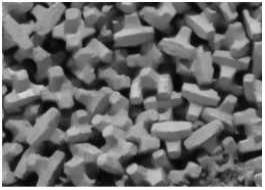
1.2 Layout of positive and negative rules
The posture of positive and trans rules shall be as follows:
(1) The ends of 3 limbs are on the ground, and the ends of the other 3 limbs are outward;
(2) The placement posture of adjacent blocks cannot be the same, that is, the end of the limb facing the sea and the end of the two limb facing the sea are placed alternately;
(3) Place in strict accordance with the connected blocks to ensure that the blocks contact closely to form a whole;
(4) Each block must be in contact with the cushion below it, and cannot be placed in the air. See the figure for the placing effect.
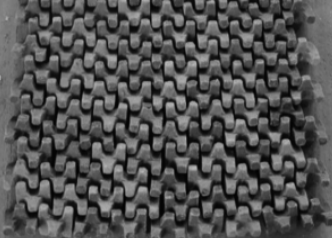
1.3 Queued regular layout
The posture of queue regular placement should be as follows:
(1) The end of the three limbs of the block should be guaranteed to land on the ground;
(2) The placement posture of adjacent blocks is the same, that is, one limb is placed toward the sea;
(3) In the horizontal direction, the flange of the adjacent block is placed parallel to each other;
(4) The adjacent blocks above and below should be closely contacted to form a whole, and the placement effect is shown in the figure.
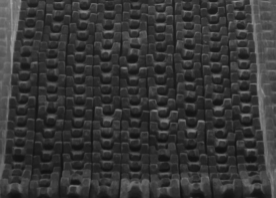
1.4 Staggered layout
The posture of staggered regular placement should be as follows:
(1) The space placement of the block must be inclined, to ensure that the three feet on the ground;
(2) The placement posture of adjacent blocks is the same, that is, one limb is placed toward the sea;
(3) In the horizontal direction, the width of one limb bar between adjacent blocks;
(4) The two limbs of the accro in the last row lean on the two limbs of the front row respectively.
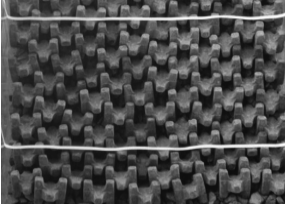
1.5 Mixed layout
Slope protection is carried out in the form of positive and negative regular placement and random placement. Below the platform is placed randomly, above the platform is placed in positive and negative rules. The placement posture of the block is determined according to the positive and negative rule placement and random placement respectively. In the placement process, the placement quality of the junction between the rule placement and random placement should be ensured.
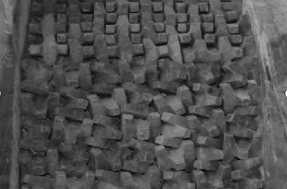
2. Applicable conditions
2.1 Random layout
Random placement only need to determine the accropode grid point position, there is no strict requirements on its positioning posture, so it is suitable for the construction of the water and underwater block, the occlusal between the block is relatively tight and stable.
2.2 Queuing regular layout
The positive and negative rules of the upper and lower rows of the accropode need to be better occlusal, so in addition to the need to determine its placement position but also to ensure its positioning posture, underwater construction is more difficult, generally suitable for water construction, the occlusal between the blocks is closer than random placement, stability is better than random placement.
2.3 Layout of Positive and negative Rules
The construction difficulty of queue regular placement is greater than the previous two, because it requires the blocks not only to occlude, but also the placement form of the upper and lower rows of blocks should be exactly the same. When underwater construction is conducted, it is very difficult. The block is mainly occluded with the adjacent blocks in the upper and lower rows, which has good stability.
2.4 Staggered layout
The gap between the blocks is concentrated, the degree of mutual occlusion is slightly low, it is difficult to ensure the consistency of the block posture in the process of placement, the block often overturn forward, underwater construction is very difficult and poor stable.
2.5 Mixed layout
The difficulty of its placement is between random placement and positive and negative rule placement, mainly because it is difficult to ensure the occlusal effect of the block at the junction of the rule and irregular placement, and the stability is worse than that of the single random placement and the single positive and negative rule placement.
3. Test results of accropode in different placement modes
(Excerpt from Key Laboratory of Coastal Disaster and Protection, Ministry of Education, College of Port Coastal and Offshore Engineering, Hohai University)
Criteria for stability: According to Wave Model Test Procedures, the criteria for slope building protective blocks should comply with the following provisions: (1) Under the action of waves, when the cumulative displacement of randomly thrown protective blocks exceeds the maximum number of a single block, it becomes unstable; for large protective blocks whose strength plays a controlling role, the cumulative displacement exceeds half of the maximum geometric scale of the block, it becomes unstable; (2) Under the action of waves, when the cumulative displacement of the single-layer paved veneer block exceeds the thickness of a single block, it becomes unstable. When the width of the gap generated by the displacement of the single-layer randomly thrown veneer block exceeds half of the maximum geometric scale of the block, it becomes unstable.
4. Conclusion
4.1 Degree of construction difficulty: The randomly placed accropode has no strict requirements on the posture of placement, the construction difficulty is minimal, and is suitable for underwater construction. The regularly placed accropode has great difficulty in underwater construction, and is generally suitable for water construction. The construction difficulty of the five ways of placing is from difficult to easy: staggered type, queue type, positive and negative type, mixed type, random place.
4.2 Voidage comparison: The voidage of the protection layer corresponding to random placement, queue placement, positive and negative placement and staggered placement are respectively 0.5, 0.4, 0.45 and 0.5.
4.3 Occlusal degree: The occlusal degree between the positive and negative accropodes is the closest, followed by random placement, then queue type, staggered type is the worst, while the mixed type blocks at the junction of the two placement modes, the occlusal degree between the blocks is worse than that of the single random placement and single positive and negative regular placement.
4.4 Comparison of stability: The stability of various placement modes from good to bad are positive and negative regular placement, random placement, queue regular placement, mixed placement, and staggered rule placement. Staggered rule placement is not recommended for accropode.
4.5 Comparison of excess waves: The excess waves of several accropodes are respectively positive and negative rule arrangement, queue rule arrangement, random arrangement and staggered rule arrangement from the largest to the smallest. There is little difference in the excess waves of positive rule arrangement and queue rule arrangement.
Ningbo Xiaolang Construction Engineering Co., Ltd.
Ningbo Tianyuan Cement Products Co., Ltd.
Yuehu Ginza, Nanzhan East Road, Haishu District, Ningbo City
+86 574 8698 8331
315012


Copyright © Ningbo Tianyuan Construction Engineering Co., LTD All Rights Reserved | Sitemap
